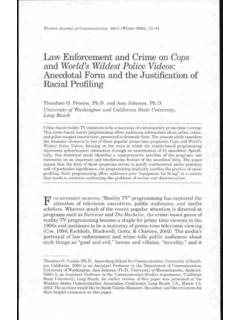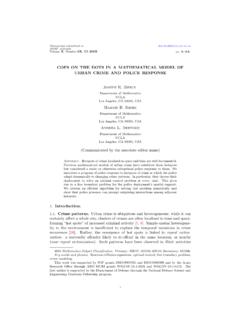Transcription of Community Oriented Policing Services (COPS)
1 Community Oriented Policing Services (COPS): In Brief Updated July 10, 2017 Congressional Research Service RL33308 Community Oriented Policing Services (COPS): In Brief Congressional Research Service Summary The Community Oriented Policing Services (COPS) program was created by Title I of the Violent Crime Control and Law Enforcement Act of 1994 ( 103-322). The mission of the COPS program is to advance Community Policing in jurisdictions across the United States. The Violence Against Women and Department of Justice Reauthorization Act of 2005 ( 109-162) reauthorized the COPS program for FY2006-FY2009 and changed it from a multi-grant program to a single-grant program. Even though the COPS grant program is not currently authorized, Congress has continued to appropriate funding for it. Between FY1995 and FY1999, the annual appropriation for the COPS program averaged nearly $ billion. The relatively high levels of funding during this time period were largely the result of Congress s and the Clinton Administration s efforts to place 100,000 new law enforcement officers on the street.
2 After the initial push to fund 100,000 new law enforcement officers through COPS grants, Congress moved away from providing funding for hiring new law enforcement officers and changed COPS into a conduit for providing federal assistance to support local law enforcement agencies. Decreasing appropriations for hiring programs resulted in decreased funding for the COPS program overall. Appropriations for hiring programs were almost non-existent from FY2005 to FY2008, but for FY2009 Congress provided $1 billion for hiring programs under the American Recovery and Reinvestment Act of 2009 ( 111-5). Appropriations for hiring programs for FY2009-FY2012 were the result of Congress s efforts to help local law enforcement agencies facing budget shortages as a result of the recession either hire new law enforcement officers or retain officers they might have to lay off. Congress has continued to provide appropriations for hiring programs even though the effects of the recession have waned over the past few fiscal years.
3 There are several issues policymakers might consider if they take up legislation to reauthorize or fund the COPS program. One potential policy question is whether the federal government should continue to provide grants to state and local law enforcement agencies to hire additional officers at a time of historically low crime rates. Policymakers might also consider whether Congress should appropriate funding for the COPS program so that law enforcement agencies could take advantage of the current single grant program authorization, or if Congress should continue to appropriate funding for individual programs under the COPS account. Community Oriented Policing Services (COPS): In Brief Congressional Research Service Contents A Brief Legislative History .. 1 COPS Funding .. 1 Select Issues .. 3 Figures Figure 1. COPS Funding, FY1995-FY2017 .. 3 Tables Table A-1. COPS Requested Funding, Total Enacted Funding, Funding for Hiring Programs, and Authorized Appropriation, FY1995-FY2017.
4 6 Table A-2. COPS Funding, by Program, FY2008-FY2017 .. 8 Appendixes Appendix. COPS Funding History .. 6 Contacts Author Information .. 10 Community Oriented Policing Services (COPS): In Brief Congressional Research Service 1 he Community Oriented Policing Services (COPS) program was created by Title I of the Violent Crime Control and Law Enforcement Act of 1994 ( 103-322, the 1994 Crime Act ). The mission of the COPS program is to advance Community Policing in all jurisdictions across the United The COPS program awards grants to state, local, and tribal law enforcement agencies to advance the practice of Community COPS grants are managed by the COPS Office, which was created in 1994 by Department of Justice (DOJ) to oversee the COPS program. A Brief Legislative History Under the initial authorization for the COPS program, grants could be awarded for (1) hiring new police officers or rehiring police officers who have been laid off to engage in Community Policing ; (2) hiring former members of the armed Services to serve as career law enforcement officers engaged in Community Policing ; and (3) supporting non-hiring initiatives, such as training law enforcement officers in crime prevention and Community Policing techniques or developing technologies that support crime prevention strategies.
5 The 1994 Crime Act authorized funding for the COPS program through FY2000 (see Table A-1 for authorized appropriations). The COPS program was reauthorized by the Violence Against Women and Department of Justice Reauthorization Act of 2005 ( 109-162). The act reauthorized appropriations for the COPS program for FY2006-FY2009 (see Table A-1). When Congress reauthorized the COPS program it changed from a multi-grant program to a single grant program under which state or local law enforcement agencies are eligible to apply for a COPS grant. These grants could be used for a variety of purposes, including hiring or re-hiring Community Policing officers;3 procuring equipment, technology, or support systems; or establishing school-based partnerships between local law enforcement agencies and local school COPS Funding From FY1995 to FY1999, the annual appropriation for the COPS program averaged nearly $ billion. The relatively high levels of funding during this time period were largely the result of Congress s and the Clinton Administration s efforts to place 100,000 new law enforcement officers on the street.
6 After the initial push to fund 100,000 new law enforcement officers through COPS grants, Congress moved away from providing funding for hiring law enforcement officers and changed COPS into a conduit for providing federal assistance to support local law enforcement agencies. Starting in FY1998, an increasing portion of the annual appropriation for COPS was dedicated to programs that helped law enforcement agencies purchase new equipment, combat 1 While there are different definitions of Community Policing the COPS Office defines Community Policing as a philosophy that promotes organizational strategies, which support the systematic use of partnerships and problem-solving techniques, to proactively address the immediate conditions that give rise to public safety issues such as crime, social disorder, and fear of crime. Department of Justice, Community Oriented Policing Services Office, Community Policing Defined, p.
7 3, this document is on file with the author. 2 Department of Justice, Community Oriented Policing Services Office, About Community Oriented Policing Services Office, 3 Even though current law states that law enforcement agencies that receive a COPS grant could use the funding for hiring or re-hiring law enforcement officers, the authority for the Attorney General to make grants for hiring or re-hiring law enforcement officer ended on September 13, 2000 (42 3796dd(i)). 4 See 42 3796dd(b). T Community Oriented Policing Services (COPS): In Brief Congressional Research Service 2 methamphetamine production, upgrade criminal records, and improve their forensic science capabilities. However, the overall appropriations for the COPS program started to decrease as Congress appropriated less funding for hiring law enforcement officers. In the early years of the COPS program, a majority of the program s enacted appropriations went to grant programs specifically aimed at hiring more law enforcement officers.
8 Beginning in FY1998, however, enacted appropriations for the hiring programs began to decline, and by FY2005, appropriations for hiring programs were nearly non-existent. Funding for hiring programs was revived when the American Recovery and Reinvestment Act of 2009 ( 111-5) provided $1 billion for COPS. Appropriations for hiring programs in FY2009-FY2012 were the result of Congress s efforts to help local law enforcement agencies facing budget cuts as a result of the recession either hire new law enforcement officers or retain officers they would otherwise have to lay off. Congress has continued to provide appropriations for hiring programs even as the effects of the recession have waned. There is a notable change in the total amount of funding Congress has provided for COPS since FY2011. From FY2012 to FY2017, Congress has provided approximately $200 million for the COPS account each fiscal year. Prior to FY2012, the least amount of funding Congress provided for COPS was $472 million for FY2006.
9 The change in annual appropriations for COPS can be attributed to two trends: (1) the congressional earmark ban and (2) Congress restructuring the COPS account (see Table A-2). Congress implemented a ban on earmarks starting with appropriations for FY2011. This ban substantially decreased funding for the Law Enforcement Technology and the Methamphetamine Clean-up programs. By FY2012, Congress did not appropriate any funding for the Law Enforcement Technology program and the only funding remaining for the Methamphetamine Clean-up program was transferred to the Drug Enforcement Administration to assist with the clean-up of clandestine methamphetamine laboratories. From FY2010 to FY2012, Congress moved appropriations for programs that were traditionally funded under the COPS account such as Project Safe Neighborhoods, DNA backlog reduction initiatives, Paul Coverdell grants, offender reentry programs, the National Criminal History Improvement program, and the Bulletproof Vest Grant program to the State and Local Law Enforcement Assistance (S&LLEA) account.
10 As shown in Table A-2, appropriations for programs that were moved to the S&LLEA account starting in FY2010 were traditionally transferred to the Office of Justice Programs. Since FY2012, Congress has not significantly changed or restructured the programs funded under the COPS account. Community Oriented Policing Services (COPS): In Brief Congressional Research Service 3 Figure 1. COPS Funding, FY1995-FY2017 Appropriations in millions of dollars Source: FY1995 through FY2011 enacted amounts were provided by the Department of Justice, Community Oriented Policing Services ; FY2012 appropriation was taken from 112-284; FY2013 appropriation was provided by the Department of Justice; the FY2014 appropriation was taken from the joint explanatory statement to accompany 113-76, printed in the January 15, 2014, Congressional Record (pp. H507-H532); FY2015 appropriation was taken from the joint explanatory statement to accompany 113-235, printed in the December 12, 2014, Congressional Record (pp.)



















